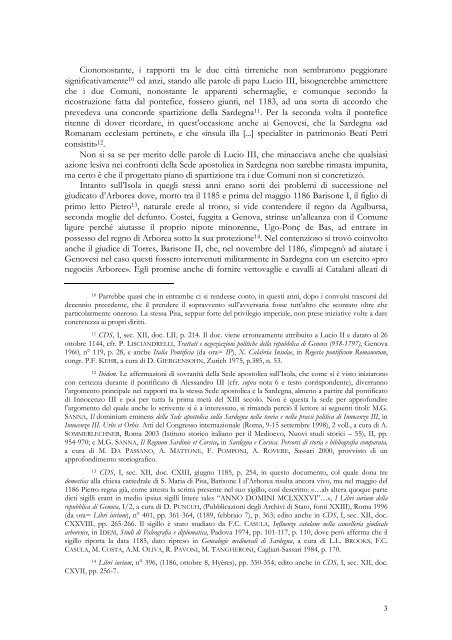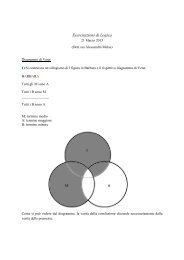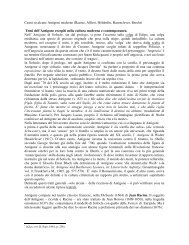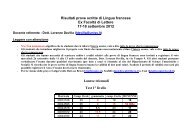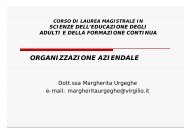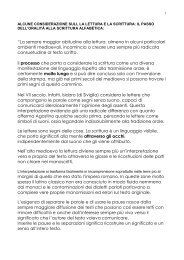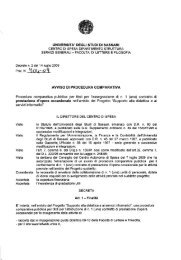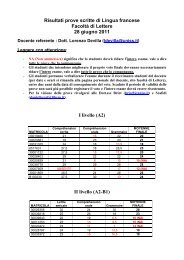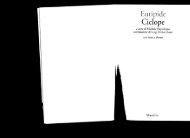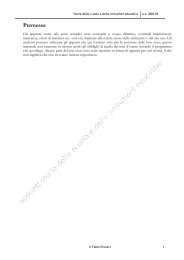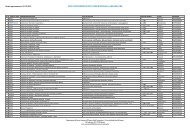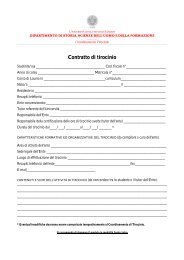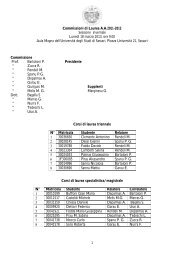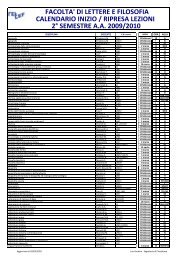Mauro G. Sanna Il giudicato di Arborea e la Sardegna tra la fine del ...
Mauro G. Sanna Il giudicato di Arborea e la Sardegna tra la fine del ...
Mauro G. Sanna Il giudicato di Arborea e la Sardegna tra la fine del ...
You also want an ePaper? Increase the reach of your titles
YUMPU automatically turns print PDFs into web optimized ePapers that Google loves.
Ciononostante, i rapporti <strong>tra</strong> le due città tirreniche non sembrarono peggiorare<br />
significativamente 10 ed anzi, stando alle parole <strong>di</strong> papa Lucio III, bisognerebbe ammettere<br />
che i due Comuni, nonostante le apparenti schermaglie, e comunque secondo <strong>la</strong><br />
ricostruzione fatta dal pontefice, fossero giunti, nel 1183, ad una sorta <strong>di</strong> accordo che<br />
prevedeva una concorde spartizione <strong>del</strong><strong>la</strong> <strong>Sardegna</strong> 11 . Per <strong>la</strong> seconda volta il pontefice<br />
ritenne <strong>di</strong> dover ricordare, in quest'occasione anche ai Genovesi, che <strong>la</strong> <strong>Sardegna</strong> «ad<br />
Romanam ecclesiam pertinet», e che «insu<strong>la</strong> il<strong>la</strong> [...] specialiter in patrimonio Beati Petri<br />
consistit» 12 .<br />
Non si sa se per merito <strong>del</strong>le parole <strong>di</strong> Lucio III, che minacciava anche che qualsiasi<br />
azione lesiva nei confronti <strong>del</strong><strong>la</strong> Sede apostolica in <strong>Sardegna</strong> non sarebbe rimasta impunita,<br />
ma certo è che il progettato piano <strong>di</strong> spartizione <strong>tra</strong> i due Comuni non si concretizzò.<br />
Intanto sull’Iso<strong>la</strong> in quegli stessi anni erano sorti dei problemi <strong>di</strong> successione nel<br />
<strong>giu<strong>di</strong>cato</strong> d’<strong>Arborea</strong> dove, morto <strong>tra</strong> il 1185 e prima <strong>del</strong> maggio 1186 Barisone I, il figlio <strong>di</strong><br />
primo letto Pietro 13 , naturale erede al trono, si vide contendere il regno da Agalbursa,<br />
seconda moglie <strong>del</strong> defunto. Costei, fuggita a Genova, strinse un’alleanza con il Comune<br />
ligure perché aiutasse il proprio nipote minorenne, Ugo-Ponç de Bas, ad en<strong>tra</strong>re in<br />
possesso <strong>del</strong> regno <strong>di</strong> <strong>Arborea</strong> sotto <strong>la</strong> sua protezione 14 . Nel contenzioso si trovò coinvolto<br />
anche il giu<strong>di</strong>ce <strong>di</strong> Torres, Barisone II, che, nel novembre <strong>del</strong> 1186, s'impegnò ad aiutare i<br />
Genovesi nel caso questi fossero intervenuti militarmente in <strong>Sardegna</strong> con un esercito «pro<br />
negociis Arboree». Egli promise anche <strong>di</strong> fornire vettovaglie e cavalli ai Cata<strong>la</strong>ni alleati <strong>di</strong><br />
10 Parrebbe quasi che in en<strong>tra</strong>mbe ci si rendesse conto, in questi anni, dopo i convulsi <strong>tra</strong>scorsi <strong>del</strong><br />
decennio precedente, che il prendere il sopravvento sull’avversaria fosse tutt’altro che scontato oltre che<br />
partico<strong>la</strong>rmente oneroso. La stessa Pisa, seppur forte <strong>del</strong> privilegio imperiale, non prese iniziative volte a dare<br />
concretezza ai propri <strong>di</strong>ritti.<br />
11 CDS, I, sec. XII, doc. LII, p. 214. <strong>Il</strong> doc. viene erroneamente attribuito a Lucio II e datato al 26<br />
ottobre 1144, cfr. P. LISCIANDRELLI, Trattati e negoziazioni politiche <strong>del</strong><strong>la</strong> repubblica <strong>di</strong> Genova (958-1797), Genova<br />
1960, n° 119, p. 28, e anche Italia Pontificia (da ora= IP), X. Ca<strong>la</strong>bria Insu<strong>la</strong>e, in Regesta pontificum Romanorum,<br />
congr. P.F. KEHR, a cura <strong>di</strong> D. GIERGENSOHN, Zurich 1975, p.385, n. 53.<br />
12 Ibidem. Le affermazioni <strong>di</strong> sovranità <strong>del</strong><strong>la</strong> Sede apostolica sull’Iso<strong>la</strong>, che come si è visto iniziarono<br />
con certezza durante il pontificato <strong>di</strong> Alessandro III (cfr. supra nota 6 e testo corrispondente), <strong>di</strong>verranno<br />
l’argomento principale nei rapporti <strong>tra</strong> <strong>la</strong> stessa Sede apostolica e <strong>la</strong> <strong>Sardegna</strong>, almeno a partire dal pontificato<br />
<strong>di</strong> Innocenzo III e poi per tutta <strong>la</strong> prima metà <strong>del</strong> XIII secolo. Non è questa <strong>la</strong> sede per approfon<strong>di</strong>re<br />
l’argomento <strong>del</strong> quale anche lo scrivente si è a interessato, si rimanda perciò il lettore ai seguenti titoli: M.G.<br />
SANNA, <strong>Il</strong> dominium eminens <strong>del</strong><strong>la</strong> Sede apostolica sul<strong>la</strong> <strong>Sardegna</strong> nel<strong>la</strong> teoria e nel<strong>la</strong> prassi politica <strong>di</strong> Innocenzo III, in<br />
Innocenzo III. Urbs et Orbis. Atti <strong>del</strong> Congresso internazionale (Roma, 9-15 settembre 1998), 2 voll., a cura <strong>di</strong> A.<br />
SOMMERLECHNER, Roma 2003 (Istituto storico italiano per il Me<strong>di</strong>oevo, Nuovi stu<strong>di</strong> storici – 55), II, pp.<br />
954-970; e M.G. SANNA, <strong>Il</strong> Regnum Sar<strong>di</strong>nie et Corsice, in <strong>Sardegna</strong> e Corsica. Percorsi <strong>di</strong> storia e bibliografia comparata,<br />
a cura <strong>di</strong> M. DA PASSANO, A. MATTONE, F. POMPONI, A. ROVERE, Sassari 2000, provvisto <strong>di</strong> un<br />
approfon<strong>di</strong>mento storiografico.<br />
13 CDS, I, sec. XII, doc. CXIII, giugno 1185, p. 254, in questo documento, col quale dona tre<br />
domestias al<strong>la</strong> chiesa cattedrale <strong>di</strong> S. Maria <strong>di</strong> Pisa, Barisone I d’<strong>Arborea</strong> risulta ancora vivo, ma nel maggio <strong>del</strong><br />
1186 Pietro regna già, come attesta <strong>la</strong> scritta presente nel suo sigillo, così descritto: «…ab altera quoque parte<br />
<strong>di</strong>cti sigilli erant in me<strong>di</strong>o ipsius sigilli littere tales “ANNO DOMINI MCLXXXVI”…», I Libri iurium <strong>del</strong><strong>la</strong><br />
repubblica <strong>di</strong> Genova, I/2, a cura <strong>di</strong> D. PUNCUH, (Pubblicazioni degli Archivi <strong>di</strong> Stato, fonti XXIII), Roma 1996<br />
(da ora= Libri iurium), n° 401, pp. 361-364, (1189, febbraio 7), p. 363; e<strong>di</strong>to anche in CDS, I, sec. XII, doc.<br />
CXXVIII, pp. 265-266. <strong>Il</strong> sigillo è stato stu<strong>di</strong>ato da F.C. CASULA, Influenze cata<strong>la</strong>ne nel<strong>la</strong> cancelleria giu<strong>di</strong>cale<br />
arborense, in IDEM, Stu<strong>di</strong> <strong>di</strong> Paleografia e <strong>di</strong>plomatica, Padova 1974, pp. 101-117, p. 110, dove però afferma che il<br />
sigillo riporta <strong>la</strong> data 1185, dato ripreso in Genealogie me<strong>di</strong>oevali <strong>di</strong> <strong>Sardegna</strong>, a cura <strong>di</strong> L.L. BROOKS, F.C.<br />
CASULA, M. COSTA, A.M. OLIVA, R. PAVONI, M. TANGHERONI, Cagliari-Sassari 1984, p. 170.<br />
14 Libri iurium, n° 396, (1186, ottobre 8, Hyères), pp. 350-354; e<strong>di</strong>to anche in CDS, I, sec. XII, doc.<br />
CXVII, pp. 256-7.<br />
3


